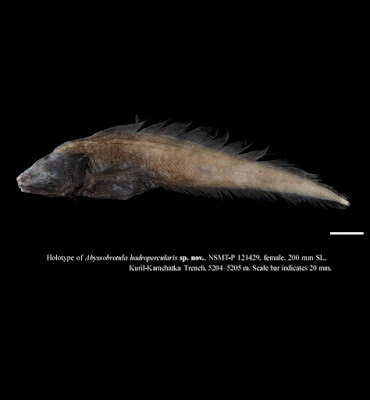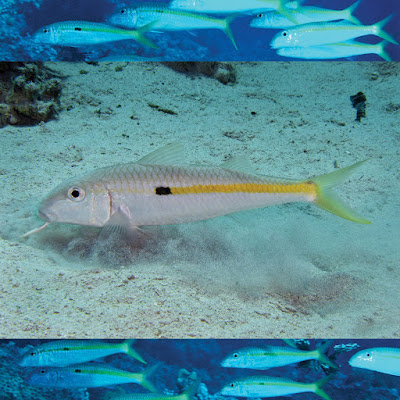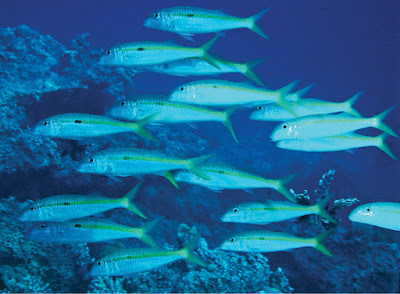[Most Recent Entries] [Calendar View]
Friday, July 15th, 2016
| Time | Event | ||||||
| 10:23a | [Ichthyology • 2016] Abyssobrotula hadropercularis • A New Species of Abyssobrotula (Ophidiiformes, Ophidiidae) from the Kuril-Kamchatka Trench
Abstract A new abyssal ophidiid fish, Abyssobrotula hadropercularis, is described on the basis of two specimens caught at two stations at ca. 5000 meters of depth in the Kuril-Kamchatka Trench. The genus Abyssobrotula Nielsen, 1977 was previously known from the type species, A. galatheae Nielsen, 1977 of which 40–50 specimens now are reported from all oceans at depths greater than 2000 m. One of the specimens from the Puerto Rico Trench captured at 8370 m is still the deepest record for fishes. The new species differs from A. galatheae in having great number of pectoral-fin rays 14–15 (vs 10–11); greater eye diameter (1.2–1.3% SL vs 0.7–0.9% SL); larger prepelvic 14.0–14.5% SL (vs 10.5–12.5% SL) and preanal lengths 42.5% SL (vs 33.0–41.5% SL); opercular spine strongly developed (vs poorly developed); gill rakers on anterior arch robust and close-set (vs rakers thin and well separated). The description of A. hadropercularis makes it necessary to slightly modify the generic diagnosis. Keywords: Pisces, Abyssal water, Abyssobrotula hadropercularis, Neobythitinae, Western North Pacific Distribution.— Known from two abyssal (5179–5223 meters) locations in the Kuril-Kamchatka Trench,Western North Pacific Ocean. Etymology.— The specific name, hadropercularis, derives from hadros (bulky) and opercularis (gill cover) in reference to the robust opercle. Shinpei Ohashi & Jørgen G.Nielsen. 2016. A New Species of Abyssobrotula (Ophidiiformes, Ophidiidae) from the Kuril-Kamchatka Trench. Zootaxa. 4132(4): 559–566. DOI: 10.11646/zootaxa.4132.4.7 | ||||||
| 2:16p | [Ichthyology • 2016] Verulux solmaculata • A New Cardinalfish (Perciformes: Apogonidae) from Papua New Guinea and Australia Abstract Verulux solmaculata sp. nov., a new cardinalfish based on 88 specimens collected from Papua New Guinea and Australia, differs from V. cypselurus, the only other known member of the genus, by the following characters: higher modal numbers of pectoral fin-rays (16 vs. 15 in the latter) and developed gill rakers (14 vs. 13), a broader black band extending over 3–5 (mode 4) rays on each lobe of the caudal fin (vs. 1–3, mode 2), and a black blotch on the caudal-fin base (vs. blotch absent). Keywords: Teleostei, Verulux cypselurus, Taxonomy, Distribution Diagnosis. A species of Verulux with the following combination of characters: pectoral-fin rays 16 (rarely 15 or 17); developed gill rakers 13–16 (modally 14); gill rakers including rudiments 17–20 (modally 18); distinct black blotch on caudal-fin base; black pigments on 3–5 (modally 4) rays on each caudal fin lobe. Distribution. Verulux solmaculata sp. nov. is currently known only from Papua New Guinea and northern Western Australia (Fig. 3), at depths of 18–20 m. Etymology. The specific name “solmaculata” is derived from Latin, meaning “sunspot”, in reference to the distinct blotch on the caudal-fin base. Tomohiro Yoshida and Hiroyuki Motomura. 2016. A New Cardinalfish, Verulux solmaculata (Perciformes: Apogonidae), from Papua New Guinea and Australia. Ichthyological Research. DOI: 10.1007/s10228-016-0539-2 | ||||||
| 2:45p | [Ichthyology • 2016] Mulloidichthys flavolineatus flavicaudus • A New Subspecies of Goatfish (Perciformes, Mullidae) from the Red Sea and Arabian Sea
Abstract The number of goatfish species has increased recently, thanks in part to the application of molecular approaches to the taxonomy of a family with conservative morphology and widespread intraspecific color variation. A new subspecies Mulloidichthys flavolineatus flavicaudus Fernandez-Silva & Randall is described from the Red Sea and Arabian Sea, including Socotra and Gulf of Oman. It is characterized by a yellow caudal fin, 25–28 gill rakers, and 37–38 lateral-line scales and it is differentiated from nominal subspecies M. flavolineatus flavolineatus by 1.7% sequence divergence at the mitochondrial cytochrome b gene. The morphometric examination of specimens of M. f. flavolineatus revealed variation in head length, eye diameter, and barbel length, in western direction from the Hawaiian Islands, South Pacific, Micronesia, and the East Indies to the Indian Ocean. The population of Mulloidichthys f. flavicaudus subsp. n. in the Gulf of Aqaba differs from that of the remaining Red Sea by shorter barbels, smaller eyes, shorter head, and shorter pelvic fins. We present a list of 26 endemic fishes from the Gulf of Aqaba and discuss the probable basis for the endemism in the light of the geological history of this region. Keywords: cytb, marine fish, glacial refugia, phylogeography, taxonomy, vicariance
Diagnosis: Body elongate, the depth at first dorsal-fin origin 4.1–4.5 in SL; head moderately compressed, the length 3.0–3.3 in SL; snout long, slightly blunt. Barbels usually not reaching a vertical at posterior margin of preopercle, their length 4.1-5.0 in SL. Eye diameter 10.3–13.5 in SL. Pectoral-fin rays 16–18. Gill-raker counts 25–28 (usually 26 or 27); lateral-line scales 37–38. Caudal fin yellowish to yellow. [Diagnosis based on the Red Sea proper population, i.e. excluding the Gulf of Aqaba, see remarks]. Etymology: Mulloidichthys f. flavicaudus subsp. n. is named in reference to the yellow color of the caudal fin, in contrast to the whitish gray color of the caudal fin of M. f. flavolineatus. Distribution: Mulloidichthys f. flavicaudus subsp. n. is restricted to the NW Indian Ocean biogeographic province, where it ranges from various locations in the Red Sea (including the Gulf of Aqaba), the Gulf of Tadjoura, the Gulf of Aden, and Socotra (Fig. 9). M. f. flavicaudus subsp. n. has extended its range to Oman (Fig. 11) and probably to the Maldives (Fig. 12), where it has encountered the western distribution of M. f. flavolineatus. Underwater photographs of fish with yellow and gray caudal fins suggest overlap and interbreeding by the two subspecies. Carpenter et al. (1997) included M. flavolineatus in their catalog of fishes of the Arabian Gulf. They did not cite any voucher specimens, and the photo they used is from Mauritius.
Iria Fernandez-Silva, John E. Randall, Daniel Golani and Sergey V. Bogorodsky. 2016. Mulloidichthys flavolineatus flavicaudus Fernandez-Silva & Randall (Perciformes, Mullidae), A New Subspecies of Goatfish from the Red Sea and Arabian Sea. ZooKeys. 605: 131-157. DOI: 10.3897/zookeys.605.8060 | ||||||
| 4:36p | [Herpetology • 2016] Bothriechis nubestris • A Cryptic Palm-Pitviper Species (Squamata: Viperidae: Bothriechis) from the Costa Rican Highlands, with Notes on the Variation within B. nigroviridis
Abstract Middle America is one of the most biodiverse regions in the world, harboring an exceptional number of rare and endemic species. This is especially true of Middle American cloud forests, where montane specialists occupy restricted, high-elevation ranges making them attractive candidates for investigating historical biogeography and speciation. One such highland-restricted species, the black speckled palm-pitviper (Bothriechis nigroviridis), occupies the Central, Tilarán, and Talamanca Cordilleras in Costa Rica and Panama. In this study, we investigate the genetic and morphological variation among populations of B. nigroviridis by inferring a multilocus phylogeny (21 individuals) and analyzing meristic scale characters with a principal component analysis (64 individuals). We find B. nigroviridis sensu stricto to be composed of two deeply divergent lineages, one with a restricted range in the northern and central Cordillera Talamanca and the other ranging throughout the Central, Tilarán, and Talamanca Cordilleras. Furthermore, these two lineages are morphologically distinct, with previously unrecognized differences in several characters allowing us to name and diagnose a new species Bothriechis nubestris sp. nov. We also examine the genetic and morphological variation within B. nigroviridis and discuss biogeographic hypotheses that may have led to the diversification of Bothriechis lineages. Keywords: Reptilia, Bothriechis nubestris, Costa Rica, Middle America, new species, snake, Squamata, taxonomy, Viperidae Diagnosis. (1) a medium-sized slender arboreal pitviper; (2) dorsum green with heavy black mottling; (3) iris blackish; (4) superciliary scales absent; (5) interrictals 22–29; (6) supraoculars thin, usually kidney-shaped; (7) intersupraoculars 6–10; (8) partial rows or two rows of irregular scales between suboculars and supralabials; (9) infralabials 9–12; (10) first dorsals usually 21 (75.9%); (11) second dorsals usually 21 (58.6%); (12) third dorsals usually 17 (85.7%); (13) ventrals 150–160; (14) subcaudals 52–64; (15) tail prehensile. Specimens of Bothriechis nubestris differ from B. schlegelii and B. supraciliaris by lacking superciliary scales (present in B. schlegelii and B. supraciliaris). Bothriechis nubestris differs from all other Bothriechis species except B. nigroviridis by having green dorsal coloration with heavy black mottling and a blackish iris. Bothriechis nubestris differs from B. nigroviridis (see Table 1 for summary) by the combination of having 150–160 ventral scales (136–149 in B. nigroviridis), thin, often kidney-shaped supraoculars with a wide intersupraocular space (B. nigroviridis usually have wider supraoculars, never kidney-shaped, with narrow intersupraocular space, and higher average counts of interrictals, dorsals, and subcaudal scales than B. nigroviridis. Etymology. The specific epithet means ‘belonging to the clouds’. It is derived from the Latin noun nubes–, is, meaning cloud, and the Latin suffix –estris, meaning belonging to. This name alludes to the fact that this species inhabits cloud forests. The common name Talamancan Palm-Pitviper refers to its range in the Cordillera de Talamanca. Tiffany M. Doan, Andrew J. Mason, Todd A. Castoe, Mahmood Sasa and Christopher L. Parkinson. 2016. A Cryptic Palm-Pitviper Species (Squamata: Viperidae: Bothriechis) from the Costa Rican Highlands, with Notes on the Variation within B. nigroviridis. Zootaxa. 4138(2) DOI: 10.11646/zootaxa.4138.2.3 |
| << Previous Day |
2016/07/15 [Calendar] |
Next Day >> |











